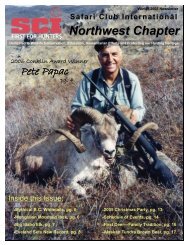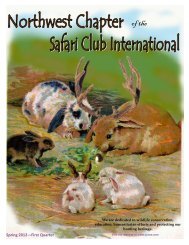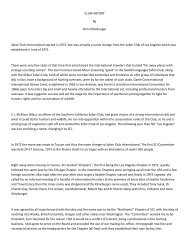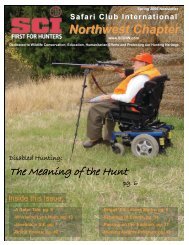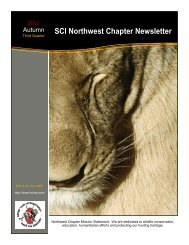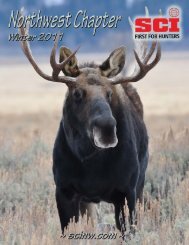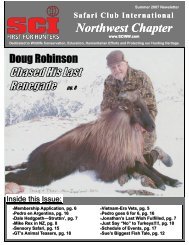The Northwest Chapter Safari Club International
The Northwest Chapter Safari Club International
The Northwest Chapter Safari Club International
You also want an ePaper? Increase the reach of your titles
YUMPU automatically turns print PDFs into web optimized ePapers that Google loves.
BY : Richard Lapinski<br />
Page Design By Lisa Endress<br />
www.scinw.com<br />
<strong>The</strong> Bear Facts<br />
ll through my adult hunting life, I heard stories of how the<br />
A timber companies had a CARTE BLANCHE license to kill any<br />
and all bears at any time of the year if the bears were on their<br />
private tree farm property. I have learned that its just not true.<br />
My education on this matter started about two years ago when I<br />
came in contact with two professional hounds‐men by the name<br />
of Tony and Brian Cebe. Tony had a contract with the Weyer‐<br />
haeuser Timber Co. to control problem bears on their tree farm.<br />
As I understood it, the reason the state of Washington started the<br />
bear predation program was due to the fact that bears belong to<br />
citizens of the state and thus the state was responsible for damage<br />
done to private property and in this case, its timber company<br />
trees.<br />
Unfortunately for the citizens of the state, the damage to privately<br />
owned tree farms could run into millions of dollars each year so<br />
there had to be a better way to control the bears and to lesson the<br />
damage and save the taxpayers money. At the same time the<br />
state had to make sure that the bears were not over harvested.<br />
<strong>The</strong>re had to be a balance, so over the years with the cooperation<br />
of the of the timber companies this plan came into being . I am<br />
sure that the plan didn’t start as smooth as it is now and had to be<br />
“tweaked” over the years.<br />
10<br />
First, when the bears come out of hibernation in the spring they<br />
are HUNGRY so they start feeding on grasses and skink cabbage<br />
etc. However, since bears have a sweet tooth, they soon turn to<br />
the tree bark of young fir trees.<br />
If you have gone into the woods in the spring where there are fir<br />
trees with the age group being 15 to 18 years old, you would no‐<br />
tice the new growth of various lengths on the tips of each branch.<br />
<strong>The</strong> color is BRIGHT green at the tips and closer to the trunk the<br />
color gets a darker green. You can even see this variation in limb<br />
color if you take a ride on any county road where there are fir<br />
trees.<br />
Now comes the situation with the interaction of bear and trees.<br />
To feed the new growth, the tree will send sugars and carbohy‐<br />
drates up through the bark. This provides a tantalizing sweet<br />
tasty sap, at least to the bears.<br />
Here in lies the problem because the bears know about this mor‐<br />
sel of sap and can probably smell it when its at the best to feed<br />
on. <strong>The</strong> bears start to strip and chew the bark around the tree.<br />
This process is called “girdling” and kills the tree. This process will<br />
start around April and continue through July. In late June or early<br />
July, the huckleberries, salmon berries and black berries have<br />
started to ripen and the sap has diminished a bit, so the bears<br />
have a change of diet . With the same sweet tooth, they hit the<br />
berries.<br />
With a mind of good stewardship for the animals as well as their<br />
trees, the first thing some timber companies do is put out large<br />
feeding cans in various spots through out their farms with a spe‐<br />
cial food containing grains, molasses and other ingredients to sat‐<br />
isfy the bear’s hunger as well as his sweet tooth. Now this works<br />
until a big nasty male bear stakes his claim on one of the cans and<br />
creates havoc on any of the younger bears who try to get near the<br />
food cans. <strong>The</strong> younger bears have to find food else where and of<br />
course the fir trees have that tasty tree bark and sap available for<br />
their needs.



